
The iRocker Cruiser 7.0 is a super-stable and versatile all-around paddle board for paddlers of all sizes.
iRocker Cruiser 7.0 iSUP Review – Overview
The iRocker Cruiser inflatable paddle board is an all-around iSUP with extra width for beginner friendly stability, paddling with a small passenger, practicing a bit of yoga, or just about anything else. The Cruiser’s moderate length and large width fit a large variety of paddler sizes and are perfect for new paddlers who want maximum stability.
Don’t just take our word about the iRocker Cruiser 7. The Cruiser was the most popular iSUP amongst Inflatable Boarder readers last year! Between the excellent shape, accessory kit, and overall value it’s easy to see why.
— iRocker Cruiser 7.0 iSUP Review Summary and Ratings —
iROCKER Cruiser 7.0
-
Construction & Durability
-
Features and Versatility
-
Stability
-
Speed
-
Maneuverability
-
Tracking
Overall Score
The iRocker Cruiser is a highly versatile and stable iSUP.
Pros
- Excellent stability thanks to its 33” width and wide shape
- Great rigidity with high-quality construction
- Very maneuverable, but still has good tracking performance
- Triple fin setup allows for more customization and performance tuning
- Efficient paddling and cruising
- Quality kit accessories included with the board
- High versatility with multiple different mounting points
- 3 year warranty on the board and 1 year warranty on accessories
Cons
- The fliplock fin boxes are very easy to use, but I’d like to see iRocker expand their range of fin shapes and sizes for more options.
- The wider shape adds stability, but does reduce overall board speed.
iRocker Cruiser 7.0 iSUP Review – Construction and Durability
The iRocker Cruiser is built with iRocker’s “Triple Layer Composite” construction for rigidity and durability while keeping both weight and cost at reasonable levels.

The double layer PVC hull is joined with double-reinforced seams and finished with additional rail reinforcement strips.
iRocker’s “Triple Layer Composite” construction is actually made up of two layers of PVC material with a third layer of fabric that is part of the internal drop stitch construction. While there are technically three different layers here, this type of construction is usually called “dual layer” (referencing the PVC) since all iSUPs have an internal drop stitch fabric layer.
The outer shell materials are made with fiber-reinforced PVC tarpaulin on the top and bottom of the board – a thick and rigid material that’s resistant to damage from impact and light abrasions. This PVC material is glued to the inner drop stitch core before the board is shaped and sealed.
Inside the board there are two knitted fabric layers (one on the deck, one on the hull) that are connected by thousands of “drop stitch” space yarns. These yarns keep the board flat when inflated and provide additional rigidity while under tension.
Once the shape of the board is cut from the material, the top and bottom layers of PVC material are joined together with a glued internal rail strip to complete the airtight chamber. A wider band of PVC is then glued around the entire rail again to protect the inner seam and provide additional support and rigidity. Lastly a narrow seam of PVC is glued onto the top and bottom edges of the outer rail band to help protect that layer from physical damage while using the board.
All together, these different pieces create a rigid, stable, and well-shaped iSUP.

There is no noticeable flex when standing and paddling normally on the Cruiser 7.0.
To test just how rigid the iRocker Cruiser 7.0 is, we put it through two separate bending tests. The first is our dry-land bend test. We place the board on an elevated surface with a 7’ gap across the middle of the board. Then we add 170 lbs of weight to the standing area and measure how much the board bends. The iRocker Cruiser did moderately well in this test with a 1.61” bend. That is almost exactly our current running average of over 120 iSUPs tested.
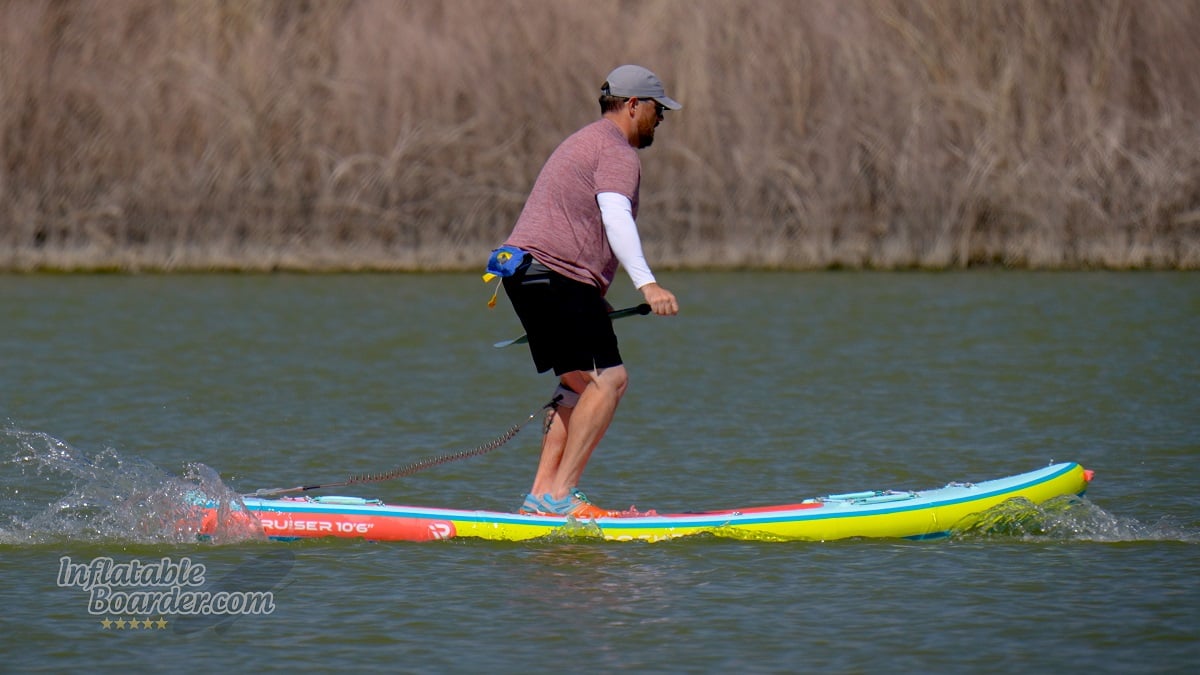
While bouncing or taking large steps there is a moderate amount of flex in the board, but it does not impact regular use.
The second bend test we do is more subjective rather than data driven, but it’s arguably more important since we do it on the water! While out paddling on the iRocker Cruiser 7.0, I do not notice any significant flexing while paddling normally or while standing on the board. I do feel a little bit of flex and vibration when I walk around on the Cruiser, but it’s minimal and feels well-controlled. When I jump up and down or paddle hard for a sprint, I do feel a moderate amount of flex in the board. When settling back down, the Cruiser has a tight, but short-lived rebound.
Overall, the iRocker Cruiser 7.0 is built very well with a classic, time-tested construction backed up with a great warranty and excellent customer service.
Specifications
| Dimensions | |
| Length | 10'6" |
| Width | 34“ |
| Thickness | 6“ |
| Weight | |
| Max Capacity | 435 pounds |
| Board Weight | 24 pounds |
| Kit Weight (SUP & accessories) | 35 pounds |
| Buying Info | |
| List Price | $ |
| Warranty | 3 years |
| Returns period | 45 days |
iRocker Cruiser 7.0 iSUP Review – Features, Accessories and Versatility
The iRocker Cruiser 7.0 is highly versatile thanks to its multitude of cargo and accessory attachment points along with its user-friendly, stable, shape.
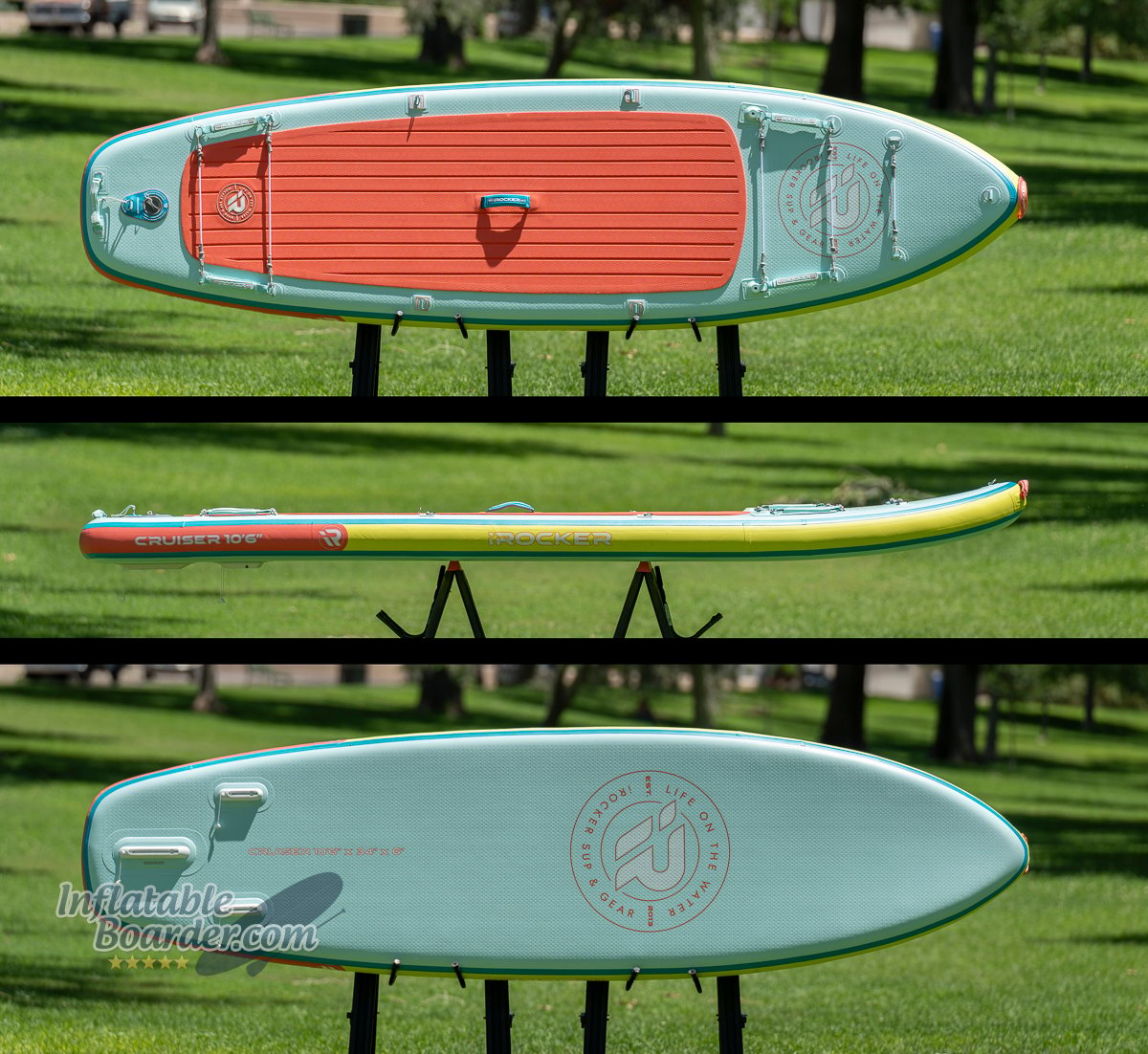
The iRocker Cruiser 7.0 is 10’6” long, 34” wide, and 6” thick. It has a maximum weight capacity of 435 lbs and a maximum internal pressure of 16 PSI.
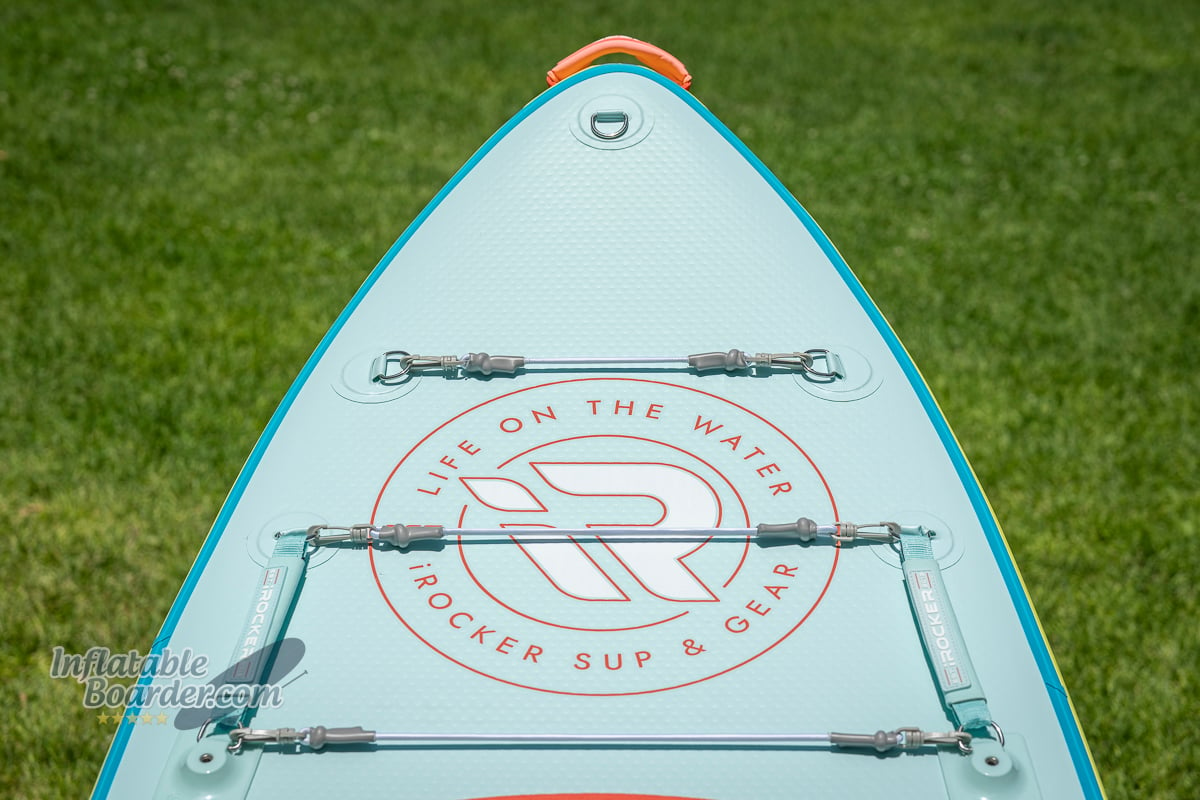
The Cruiser’s nose is very wide for great stability and additional weight capacity.
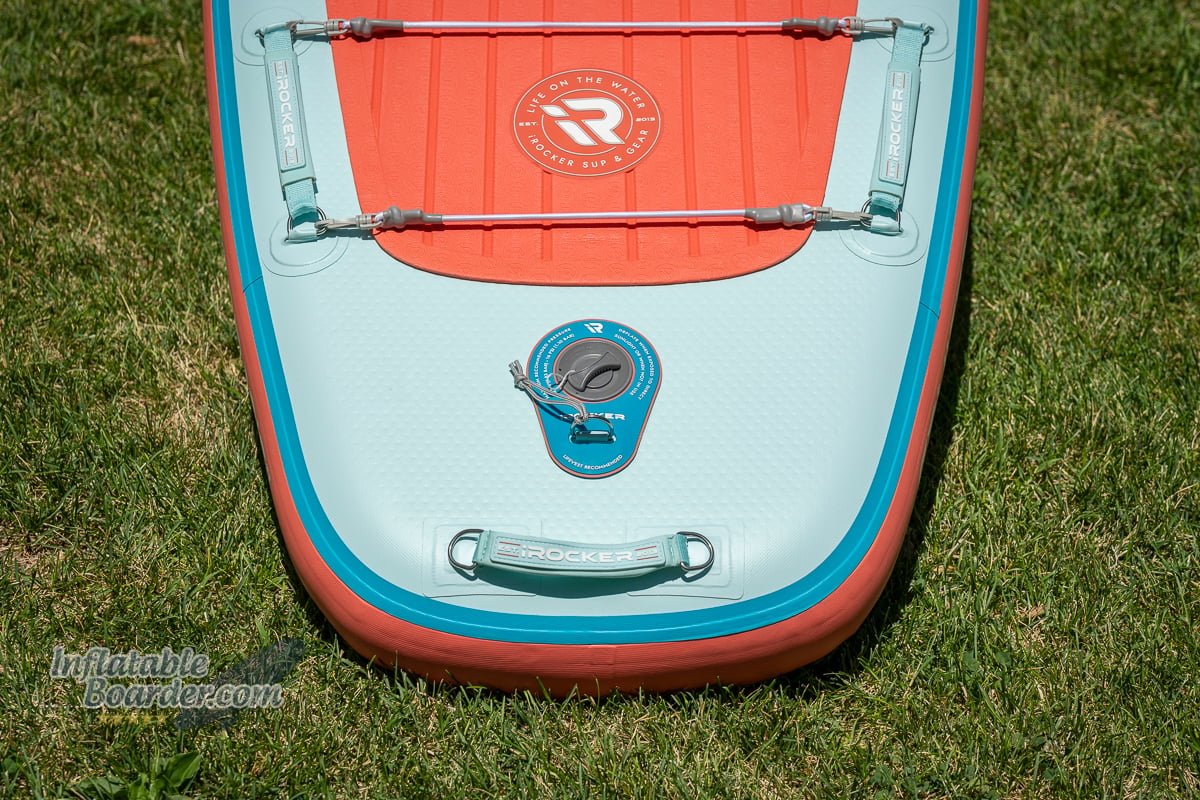
The tail of the board ends with an extra wide square shape. This helps keep the Cruiser 7.0 as wide as possible through most of its length giving it excellent stability and a high carrying capacity.
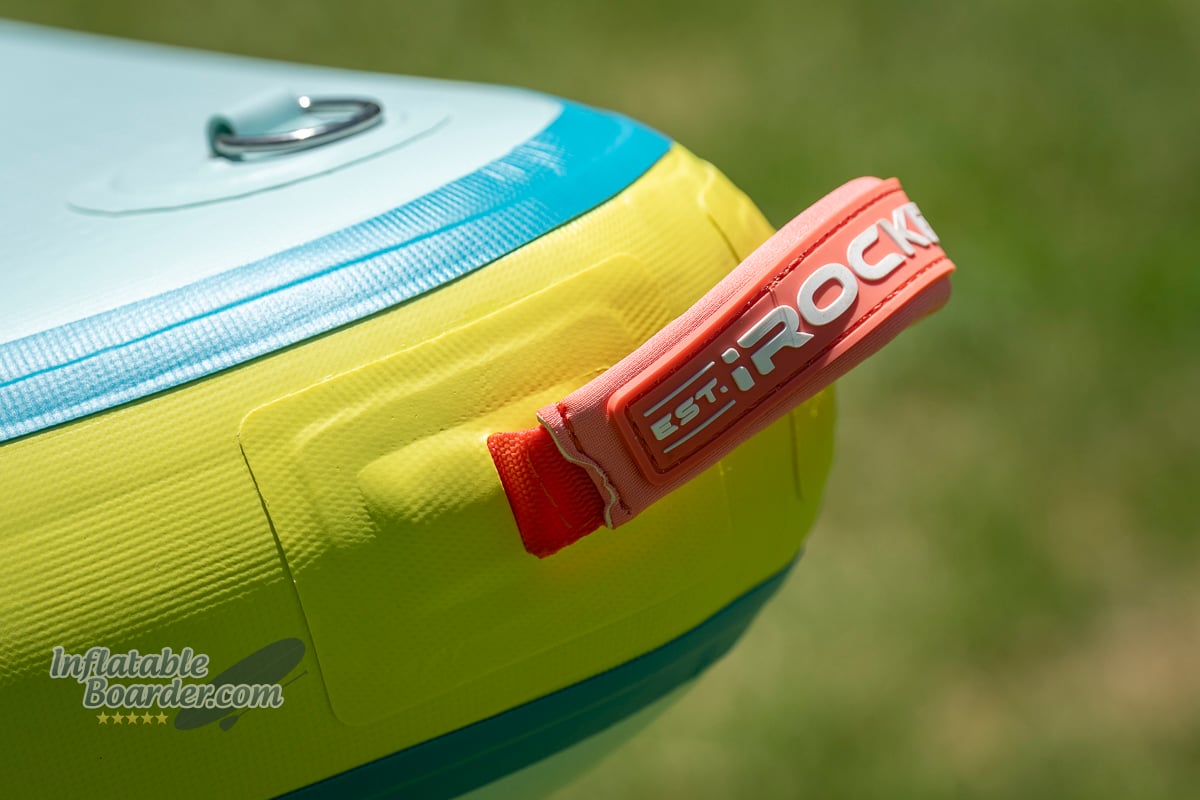
There are three padded handles on the Cruiser 7.0 including one on the nose and tail for carrying with a partner, and one in the middle of the board for carrying by yourself.

There is a D-ring for anchoring or towing the board on the top of the nose.
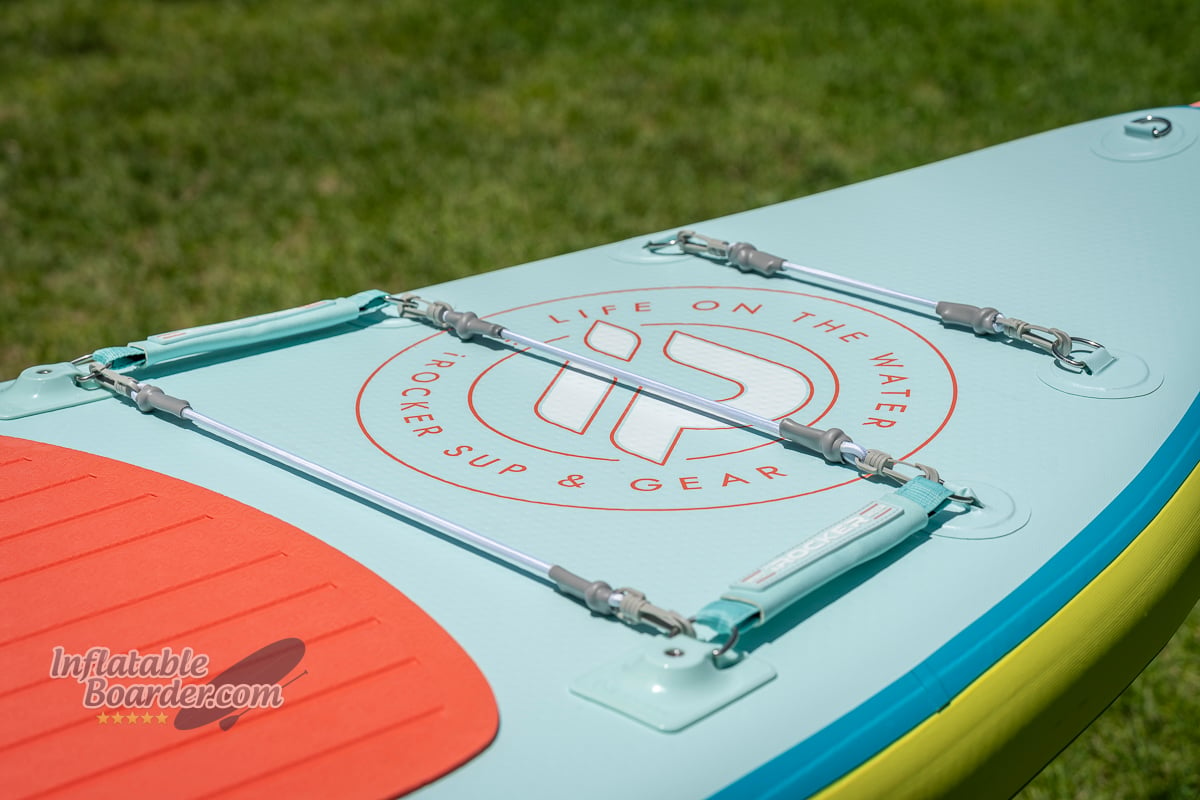
The front cargo area is built across six D-rings and covers a rather large area. There is enough room under the cargo bungee cord for medium or large dry bags, and larger items can be tied down to the D-rings themselves. Rather than having a single bungee cord for the entire cargo area, the Cruiser 7.0 has three separate removable bungees that can be arranged in different configurations.
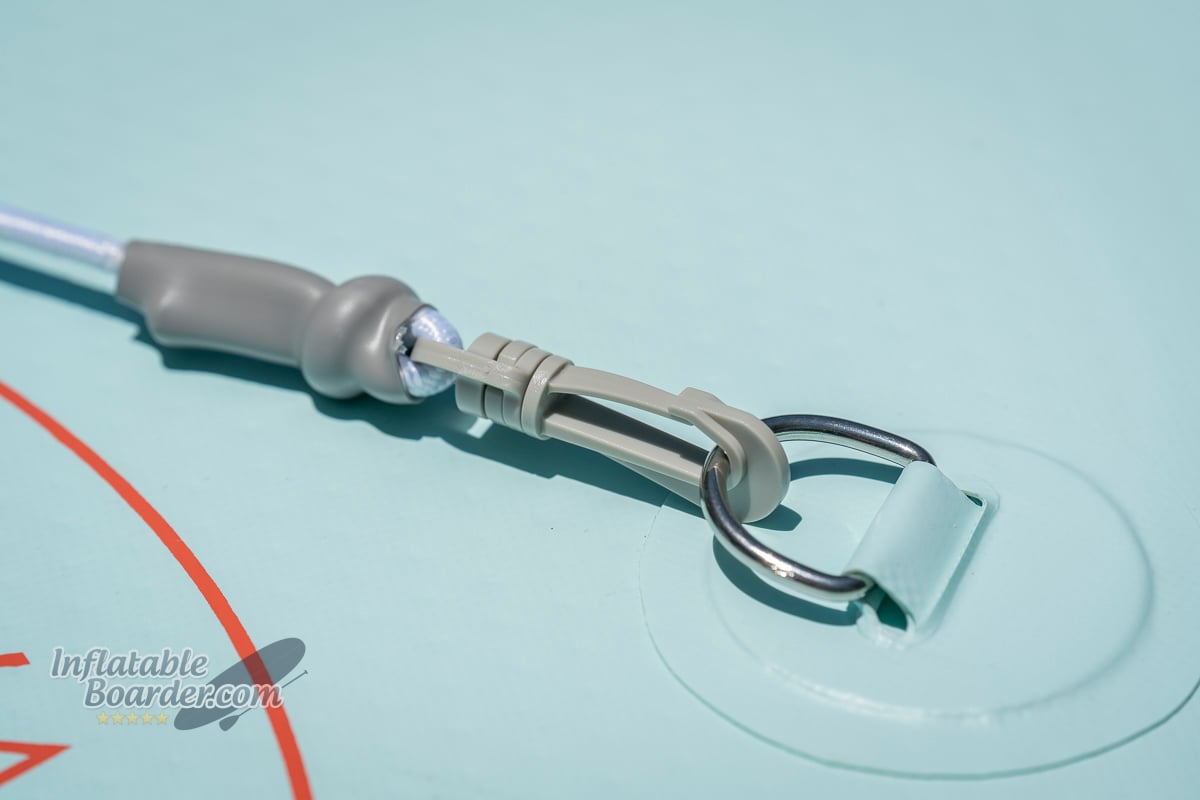
Each bungee cord has a clasp on either end to quickly remove, install, or change locations.

There is a set of removable padded handles on the front cargo area for passengers to hold.

The Cruiser 7.0 has two threaded accessory mounting points at the front cargo area. You can use these to hold phones, gps units, speakers, and other accessories.

The EVA foam deck pad covers the rear two-thirds of the board. The pad has a logo-embossed texture and grooves for a great blend of comfort and traction.
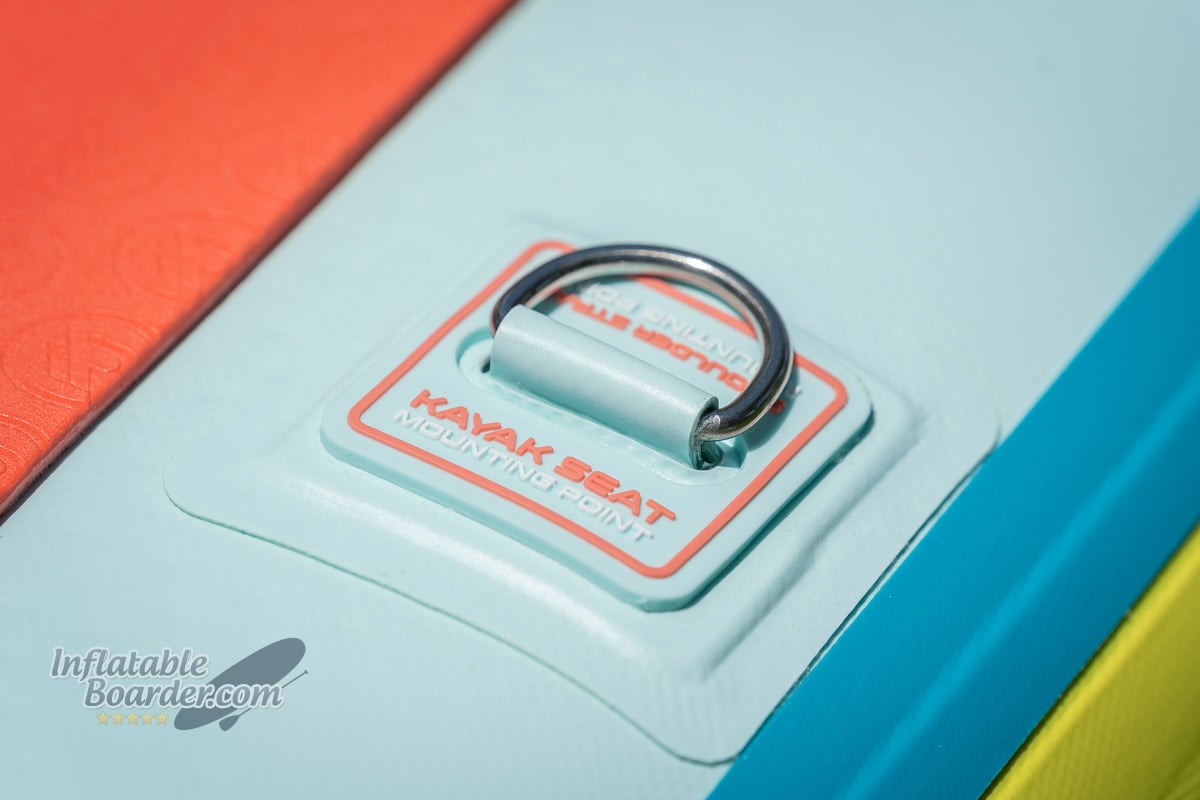
There are four D-rings around the middle of the board that can be used with the iRocker shoulder carrying strap when moving the board around off the water, or with the iRocker seat for conversion to a hybrid kayak.

The rear cargo area has two removable bungee cords and two more removable passenger handles.

Under the board are three fliplock style fin boxes with fin tethers.
Last year, iRocker updated the Cruiser 7.0 to include a full kit of accessories with purchase rather than using a kit-builder system. The new kit includes a rolling backpack, electric pump, and carbon fiber/hybrid paddle.

The iRocker Cruiser 7.0 comes with fins, leash, repair kit, rolling backpack, electric pump, and three piece paddle .
iRocker Cruiser 7.0 iSUP Review – Paddle
The iRocker Cruiser 7.0 now includes the iRocker Hexa-Edge paddle as part of the standard accessory kit shipping with the Cruiser 7.0 SUP.
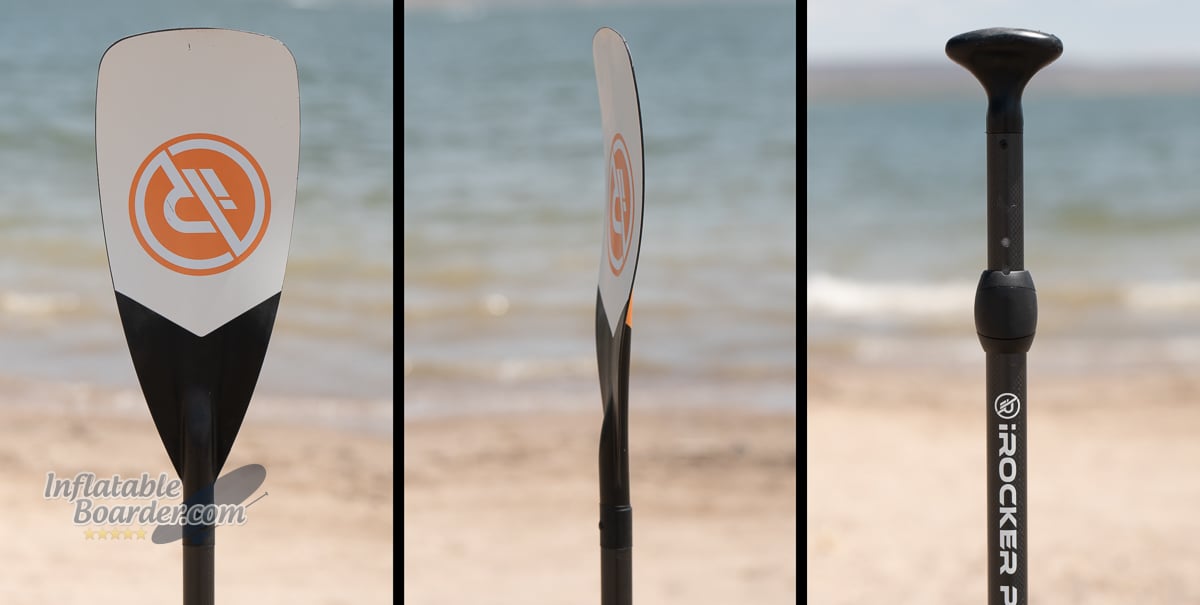
The iRocker paddle has a user-friendly nylon blade and lightweight carbon fiber shaft.
It’s pretty rare to find a SUP paddle with a carbon fiber shaft included with a paddleboard in the same price range as the iRocker Cruiser. Carbon fiber paddle shafts are usually the lightest weight options (that’s not always the case, but it trends that direction) and typically provide a better stiffness profile. The iRocker paddle has a medium weight and medium flex profile. Combined with a medium size blade and it’s a paddle that’s ready to fit most paddlers in most situations. The moderate amount of flex between the paddle shaft and blade makes the iRocker paddle comfortable for casual paddling all day.
The new Hexa-Edge paddle uses a hexagonal ferrule to connect the blade and shaft sections together. This eliminates any wiggle or play between the two sections for a solid feel in your hand.
The blade is made of a fiber-reinforced nylon material. This is far more impact resistant than composite materials like fiberglass or carbon fiber, but it is heavier. The thinner, more flexible blade does balance well with the rest of the paddle compared to thicker, larger blades. The curved blade shape is intuitive for beginner paddlers, but doesn’t offer all of the benefits of a straighter blade with a higher angle to the shaft.
The handles section of the paddle is also made of carbon fiber, but is topped with a plastic palm grip. I sometimes found the palm grip to feel soft – mostly while paddling with a lot of force for our speed testing – but was otherwise comfortable.
The iRocker paddle uses a pin-and-clip system to adjust the length of the paddle from 72-86” long and the pins have the added benefit of automatically aligning the blade and the handle together.
iRocker Cruiser 7.0 iSUP Review – Stability
The Cruiser 7.0 is built for a comfortable time on the water for beginner paddlers, paddling with a small passenger (a small dog or child) and for larger paddlers. The width and shape work well together to keep the Cruiser comfortably stable all day.
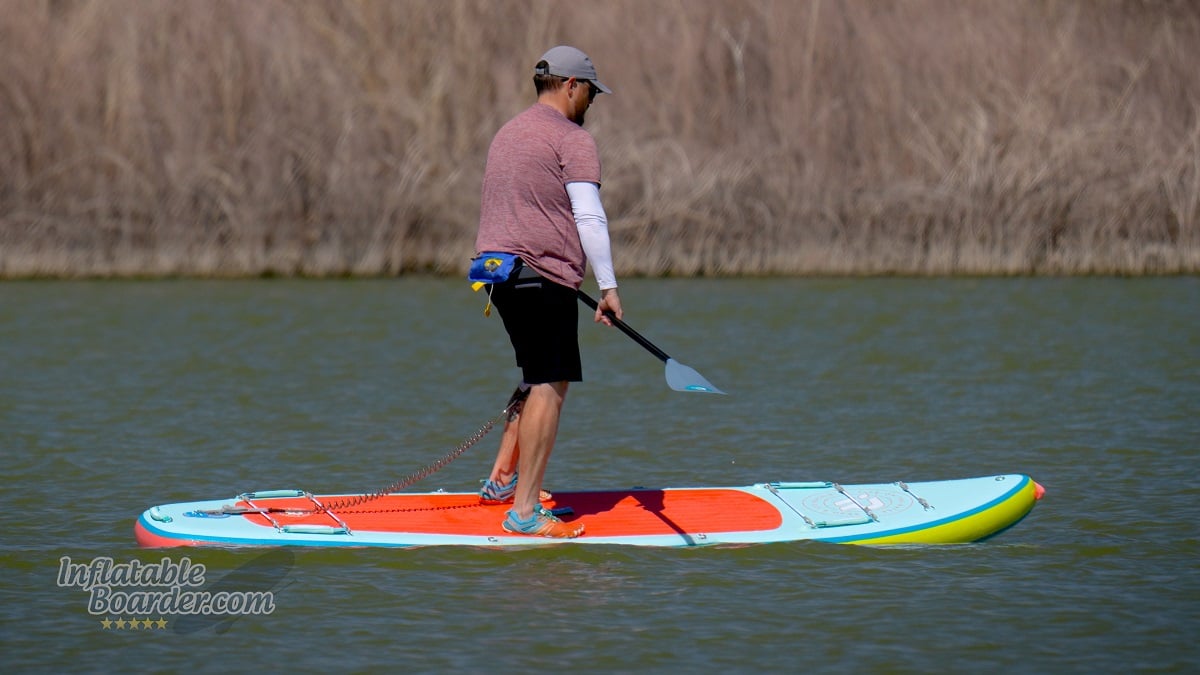
The iRocker Cruiser 7.0 has excellent stability – even when tilted on to its side.
Cruiser-style iSUPs are known for their stability and laid-back paddling style. Comfort over performance is the mantra with these boards (but that doesn’t mean comfort without performance). The iRocker Cruiser 7.0 is 10’ 6” long and 34” wide at its midpoint. It’s a great size to accommodate a wide range of paddler sizes and weights, though petite paddlers under 5’6” without a passenger may find the Cruiser 7.0 to feel a little large. The relatively wide semi-square tail and wide nose also do a great job of providing stability when you aren’t standing in the middle of the board or when you have a passenger or equipment up front.
While standing and paddling on the Cruiser I didn’t experience any twitching or rocking sensations. The initial stability is very confidence inspiring, and the Cruiser is a board I often have beginner paddlers use when first learning to SUP.
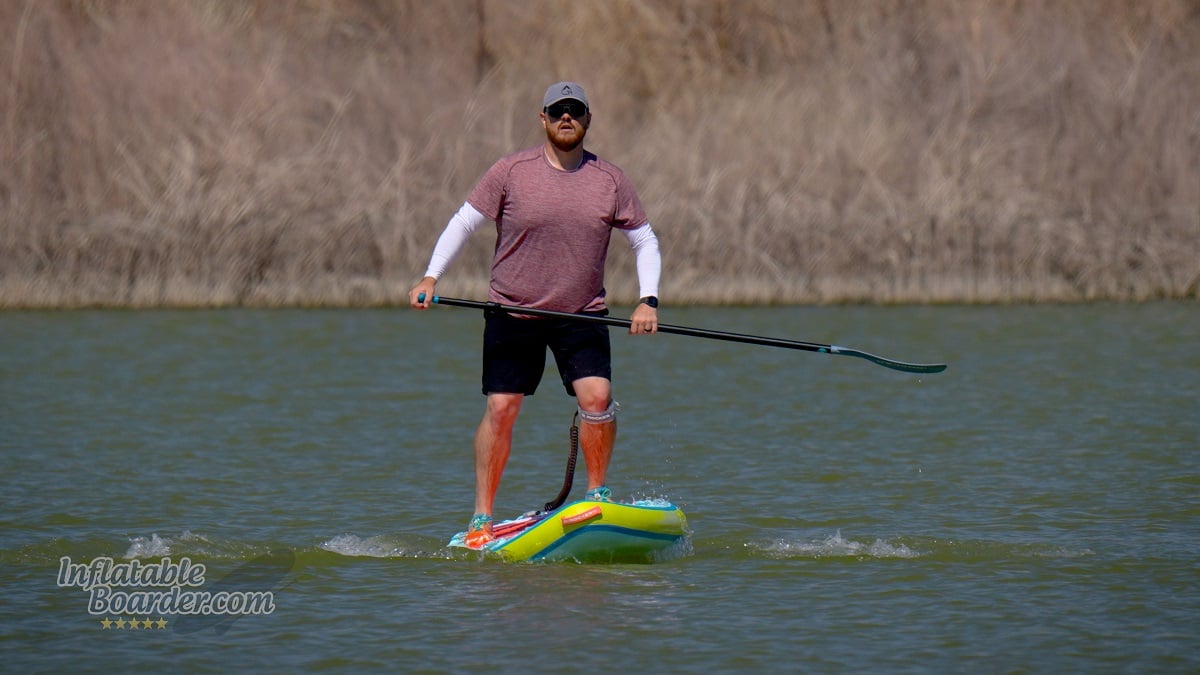
Rocking the Cruiser 7.0 back and forth is smooth and consistent.
If you do get a little wobbly, or encounter some boat wake or waves, the Cruiser 7.0 also stays stable when it’s not perfectly flat. This secondary stability helps you stay upright on the board when things get choppy. While purposely rocking the board side to side the Cruiser has a comfortable resurface and return to its normal paddling position without any overly-buoyant feeling reactions. Holding the Cruiser on its edge is also quite easy to do thanks to the way the width carries through the nose and tail of the board. This keeps more surface area in contact with the water for a more stable feeling.
While walking back to the tail of the board I did feel just a little bit of flex and vibration, but it settled out very quickly. Sinking the tail to lift the nose took a little bit of effort (again, it’s on the larger side), but once I did I was very comfortable and could easily spin the board around for a series of pivot turns without needing to set it back flat on the water.
iRocker Cruiser 7.0 iSUP Review – Speed
The iRocker Cruiser 7.0 prioritizes stability and comfort over hitting higher speeds, and I’m 100% OK with that. This style of board is designed for cruising!
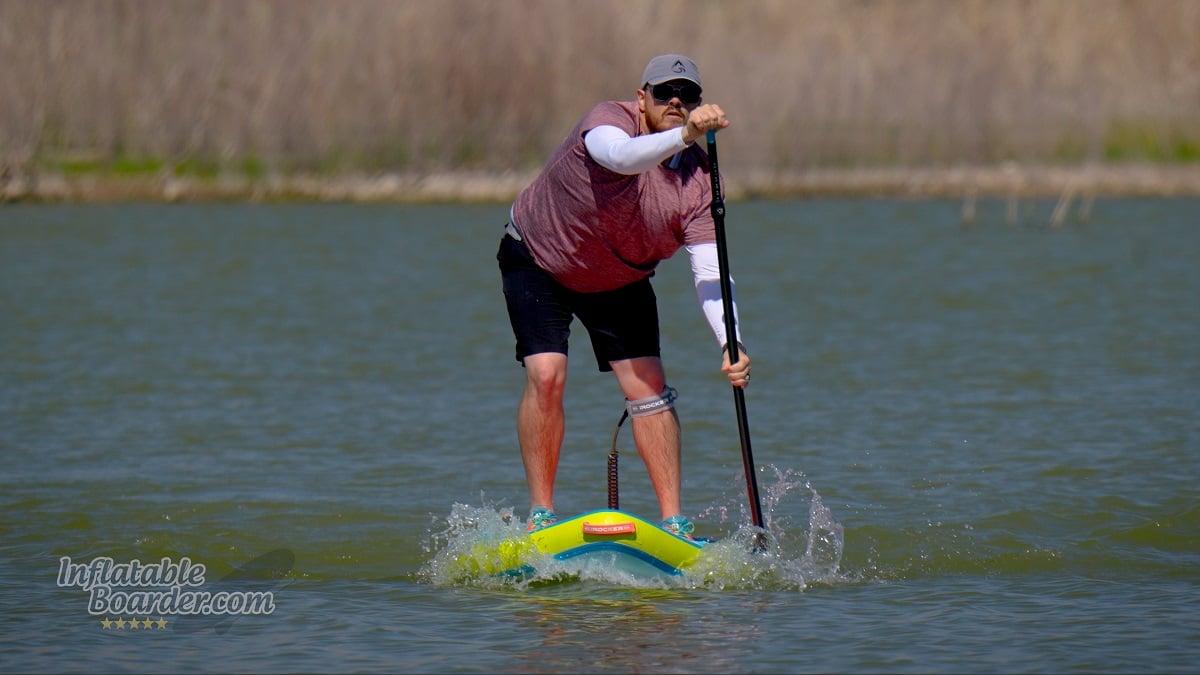
The Cruiser’s 34” width is great for stability, but does detract from its overall speed and efficiency.
The first part of our board speed evaluation looks at raw speed for short sprints and top possible speeds. I was able to maintain an average sprinting speed of around 4.7 MPH and hit a top speed of just 5.2 MPH. These are a little bit on the slower side of things, even for a cruiser-style SUP, but this is a paddle board meant for relaxation, not sprint racing.
The second part of our speed evaluation looks at average cruising speeds and efficiency. Cruising on your SUP is a leisurely activity and is great for enjoying your surroundings, wildlife, and friends. So even our modest pace of 25 strokes per minute (essentially taking a short pause between strokes) is still a relatively fast cadence, but it’s easy to maintain for long distances. At this pace, the iRocker Cruiser 7.0 moves along at an average of 3.4 MPH. This is more typical for a wider, cruiser-style paddle board. But more importantly, it felt comfortable while paddling at this speed. I didn’t feel the width of the board really impacting its cruising speed like it does its sprinting speed.
With each paddle stroke the iRocker Cruiser glides about 18 feet before it slows down. With a 10’ 6” overall length, that gives the Cruiser a glide ratio of about 1.7 board-lengths per stroke. That’s actually quite good for an iSUP of this width. The higher the glide ratio the fewer paddle strokes you’ll have to take to go a set distance. So while the iRocker Cruiser 7.0 isn’t the overall fastest board we’ve tested, it paddles with the speeds we expect (which is a good thing) and does so rather easily.
iRocker Cruiser 7.0 iSUP Review – Maneuverability and Tracking
Tracking and maneuverability can sometimes be a bit like having cats and dogs in the same house. Yes they’re both there, but not always at the same time. The iRocker Cruiser does a great job of bringing both of these characteristics into one board, but does favor maneuverability more than tracking.
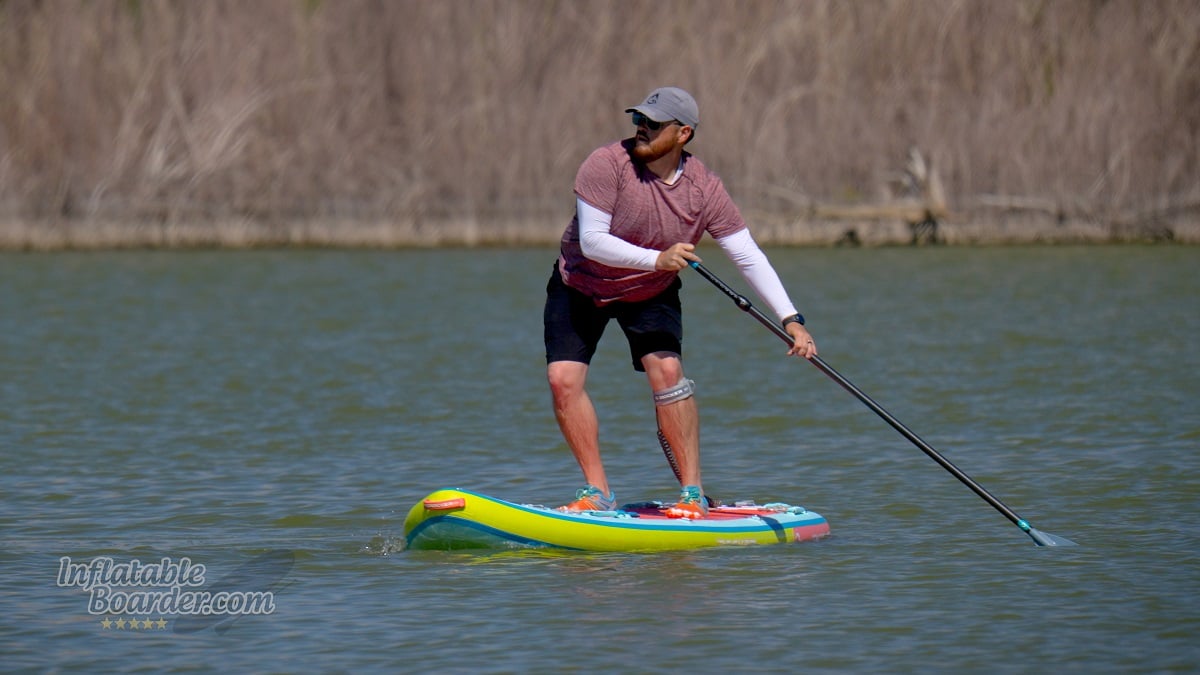
The Cruiser 7.0 is very easy to turn even with all three fins installed.
All of our testing is designed to stress our equipment to highlight its strengths and show us its weaknesses. Our maneuverability test specifically uses forward sweep strokes (paddling in an arc from the nose to the tail) for this reason, and because they are one of the first turning strokes new paddlers will learn how to do to turn their board.
Using just forward sweep strokes, I found that it takes the iRocker Cruiser an average of just over 4.5 strokes to turn in a complete circle from a standstill. That’s quite quick, and is a significantly smaller turning radius than a lot of other all-around style paddle boards I’ve tested (my average for all-around boards is around 6 strokes).
Using other paddle strokes and techniques will turn the Cruiser even faster. Reverse sweep strokes spin the board in just 3 strokes. And of course stepping back onto the tail for a pivot turn makes that even faster (though a little trickier).

Straight line tracking on the cruiser is very good compared to similar-sized all-around iSUPs.
With excellent maneuverability performance I didn’t expect the Cruiser 7.0 to do overly well in our tracking test. Here we start by paddling toward a target on the horizon. Once the course is set, I take 10 strokes on a single side and then measure the difference between my new course and the old course with a compass. The iRocker Cruiser averaged 19° of deviation over 10 paddle strokes. This is about what we expect to see with wider, cruiser iSUPs as the extra width makes it harder to keep the board moving straight.
Now, this test is done with effort to use the best forward stroke technique I can to keep the board as straight as possible. During regular paddling I did feel that the Cruiser was drifting and turning a little more than I would normally like and needing to switch paddling sides a little more frequently than normal for me. Overall, though, the Cruiser still has respectable tracking performance, and it also responds easily to any steering input to change or correct your course while paddling.

The three Surf/All-Around style fins favor maneuverability more than tracking, but still provide a good balance of each.
All of these tests were done while using all three of the fins that are included with the iRocker Cruiser. There are two 4.5” side fins and one 9” center fin that match to their corresponding fliplock fin boxes. All three of the fins have a swept back “dolphin” or “surf-style” fin shape which does favor maneuverability over tracking. The fliplock fin boxes are easy to use and require no tools or bolts for installing and removing your fins. This style of fin box is not the most common or standard in the SUP world, and so fin choices are a little bit limited. I would like to see iRocker expand their fin offerings for more user customization.
iRocker Cruiser 7.0 iSUP Review – Warranty and Customer Support
iRocker offers a 3 year warranty on the iRocker Cruiser 7.0 iSUP against seam leaks and a 2 year warranty against other manufacturing defects. The included accessories also receive a 1 year warranty. Additionally, the iRocker Cruiser does have a 45 day return policy in case you find out that it does not suit your paddling style. Customers are responsible for return shipping and refunds may be subject to a reduction based on the condition of the board. If you have any questions, you can contact iRocker via telephone, email, webform, and social media.
iRocker Cruiser 7.0 iSUP Review – Overall Impressions/Review Summary
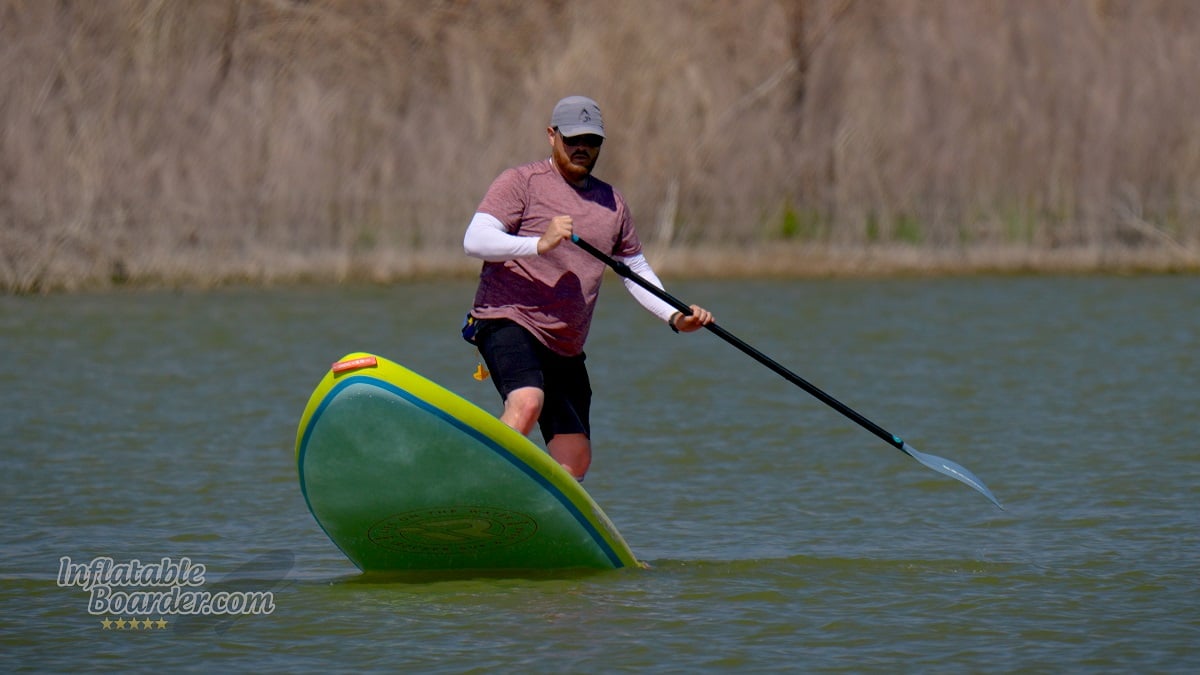
The iRocker Cruiser 7.0 is a super versatile and stable all-around iSUP that fits a huge variety of paddlers.
The iRocker Cruiser 7.0 is an excellent choice for beginner paddlers, paddling with smaller passengers, or just as a comfortable and stable inflatable paddle board that has a lot of different features for different uses. It’s one that I always bring along with me when I work with new paddlers (and one I recommend often). The quality and performance of the board, the quality of the accessories, and the three year warranty all make the iRocker Cruiser an excellent choice for any paddler – and doubly so when considering the actual price of the kit.
iRocker Cruiser 7.0 iSUP Review – FAQ
Nautical vs. iRocker vs. Blackfin— which SUP should I buy?
If you’re on a tight budget and money is an issue, we’d recommend the Nautical. If you can afford to pay a bit more for an inflatable SUP, then we’d highly recommend bumping up to the iRocker or Blackfin range. Blackfin iSUPs offer more features for anglers and are larger and stiffer as well.
iRocker Cruiser 7.0 vs the iRocker Cruiser Ultra - what’s the difference?
The Cruiser 7.0 is 34” wide and built with a standard construction that rolls into a normal-size iSUP bag. The Cruiser Ultra is 33” wide and is built with an extra light construction and a split design to fold into a much smaller compact bag for easier transportation and storage. The Cruiser 7.0 is sold as the board-only or with a full kit via iRocker’s kit builder tool while the Cruiser Ultra is only sold as a complete kit including an electric pump and 5-piece paddle.
How long does it take to inflate the iRocker Cruiser 7.0 iSUP?
Depending on how quickly you pump, the iRocker Cruiser can be inflated in as little as 5 minutes, but average inflation time is closer to 8 minutes.
Is the iRocker Cruiser 7.0 compatible with a kayak seat?
Yes! The iRocker Cruiser has four D-rings around the middle of the board that are compatible with the iRocker kayak seat and inflatable kayak seat.
Do I need to use all three fins with the iRocker Cruiser7.0?
No, you don’t need to, but changing the fins setup will change the performance. Using just the center fin will be a little more maneuverable, but will track a little less straight. It will also be a little bit faster. Using just the side fins, the Cruiser will be significantly more maneuverable and can be paddled in shallower water, but will lose more tracking ability.
How long will the iRocker Cruiser 7.0 last?
WIth proper care and regular maintenance, your iRocker cruiser will keep you paddling for many years. Always clean and dry your board before storing it, avoid over pressurization, and store in a cool, dry place out of the sun.
Can I paddle with kids or dogs on the iRocker Cruiser 7.0?
Absolutely. The extra width of the iRocker cruiser makes it a great choice to use with kids and smaller dogs. For larger kids or dogs I do recommend looking at a larger board like the Blackfin Model X for even better stability.
 10
10 

Jesse says
Would you recommend the Cruiser 7.0 or the cruiser ultra 2.0 for a beginner? I’m 200lbs and would occasionally have the dog out on the water 50lbs Lab. Any advice you can provide is appreciated.
Mike Carney says
I would recommend the Cruiser 7.0, especially with the dog. It’s a little bit wider for more stability and it has a larger deck pad for the dog. If your lab is anything like mine, they’ll be wanting to constantly jump on and off, so the extra stability will be welcome.
Simcha tzuf says
Hi
Thanks for you helpful review.
Do you know how the irocker cruiser compares with the stx 10.8 cruiser?
We live in Israel and there isn’t irocker available locally. So I’m debating between ordering directly from irocker and dealing with import tax, or getting something local like stx
Mike Carney says
Hi there, unfortunately I’ve not tested an STX 10.8 cruiser so I can’t make any direct comparison. If you are able to demo an STX locally, that would be the best way to go to see if you like it first.
William says
Hi,
I’m trying to decided between the cruiser and all around 10′ for my 5’3″ wife’s birthday present. She has excellent balance, but we have small school aged children so a 7 year old might ride with her. I like the cruiser for the stability, but I don’t want to get a board she will out grow in skill level quickly. Any advice? We have a lake, like to camp, and maybe the ocean like one day a year. Thanks.
Mike Carney says
Hi William, apologies for the late reply (it’s been a very busy summer!) If taking the 7 year old will be a moderately-regular activity, then I would recommend the Cruiser over the 10′ All Around for that extra stability (in both the iRocker original and Ultra versions). Both are great beginner boards and excellent to have on hand even if she does begin to outgrow it. Typically the “next” board many people like as they start to outgrow an all-around or cruiser is a touring-style board – longer and narrower for faster, more efficient paddling. However these touring boards don’t always make great beginner options.
Catherine says
Hi,
I’m looking to purchase my first SUP. We are in the UK and I would mostly paddle in the estuary which can vary greatly from almost flat conditions to choppy with a fast current when the tide is running. Would the Cruiser be my best bet to cope with the changeable conditions or would the All around 11 cope better?
Many thanks for your help and great reviews.
InflatableBoarder.com says
Hi Catherine, thanks so much for the nice comment. I’d choose the CRUISER for the added stability, especially since this is your first board. Also, I’m not sure if you’re aware of this, but you can order the CRUISER direct from iROCKER’s UK website and it includes free shipping.
Hope that helps. Happy paddling and enjoy the board!
Liz says
Hi! Just purchased 2 cruisers and had a great experience, but it was very windy and we struggled to get much distance. Do you think that the 11′ all around would be a better bet? We’re beginners and will be bringing our 3 year old often, so stability is key, but we’d like to go a bit faster!
InflatableBoarder.com says
Hi Liz, thanks for your comment.
I think you would notice some improvement in this case with the iRocker ALL-AROUND 11′, but keep in mind that super windy conditions are going to make for a more challenging paddle regardless. If you’d prefer to make the jump up to the ALL-AROUND 11′, I’d drop the guys at iRocker a line to see what they can do for you.
Happy paddling!